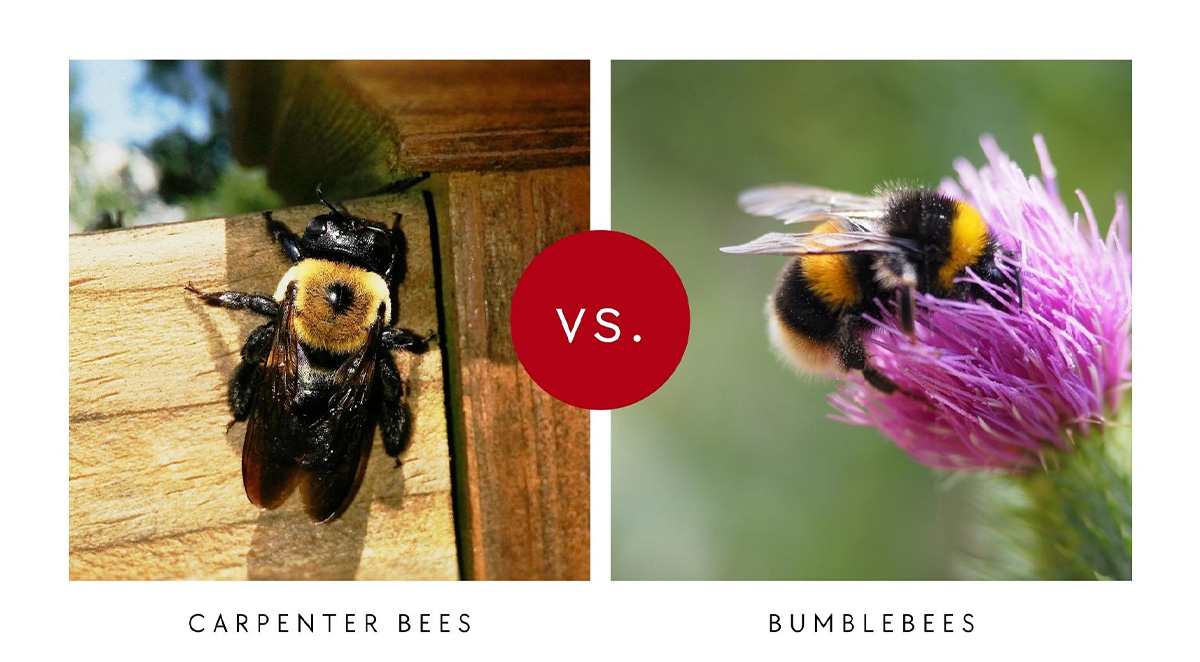Why Carpenter Bees and Bumble Bees Are Often Mistaken for Each Other
Why is it that these two very different types of bees are commonly confused for each other?
Bumble Bees
Appearance: The head, thorax, and abdomen of a bumble bee are all fluffy. A faint yellow line runs along the thorax, and the abdomen is yellow and black. Bumblebees can be anywhere from three-quarters of an inch and one and a half inches long.
Home: Bumble bees develop colonies close to the ground. They prefer compost, woodpiles, or piles of leaves. Bumble bees are sociable insects that dwell in groups of fifty to four-hundred individuals. The other bumble bees collect food to feed the queen and attend to the growing larvae.
Behavior: Bumble bees gather nectar and pollen from flowers. They may make flowers release pollen by vibrating their wings quickly. If they feel threatened, they can repeatedly sting without losing their stinger; however, they are typically quite docile around humans.
Carpenter Bees
Appearance: Carpenter bees have a black abdomen that is bare and glossy. They are approximately one inch long. Some carpenter bees feature yellow thoraxes, while some have white, black, brown, or blue thoraxes. Carpenter bees look a lot like bumble bees.
Homes: Carpenter bees construct their hives in wood by making a hole and then rotating ninety degrees to dig a tunnel wherein they can lay their eggs. They are typically not social, with just one female living in each tunnel.
Behavior: Carpenter bees fly close to wood siding, porches, decks, roofing eaves, and fences, either while they are excavating a nest or feeding the larvae within. Male carpenter bees cannot sting, but they have been known to buzz around a person’s head if they feel threatened. Female carpenter bees can sting if the nest is disturbed.
Are Carpenter Bees or Bumble Bees Dangerous to Your Home or Family?
It can be difficult to identify whether or not the yellow and fluffy black bees flying around your property are bumble bees or carpenter bees. The best way to differentiate between the two is their behavior. Bumble bees will be buzzing around your flowers and pollinating plants, while carpenter bees will be flying near the wooden parts of your home.
While carpenter bees can be dangerous and damaging, bumble bees can be helpful.
Bumble Bees Can Be Helpful
While the idea of having bees can be scary, especially if you have children, bumble bees are generally mostly harmless. Pollination is just the movement of pollen from a male plant species to a female plant species. Because it is the only method many species receive fertilization, it is critical for supporting healthy crops and plant growth.
Pollination is required by almost a thousand plants that we rely on for food or medication. Insects and other small animals are the most prevalent pollinators. Among insects, bees are the best pollinators we have. While the sight of bumble bees might be alarming, they are doing good work by renewing life on your property.
Carpenter Bees Can Be Harmful
The tunnels carpenter bees bore into your home’s wooden surfaces can be harmful to your property. Tunnels can grow up to several feet in length over many generations.
Carpenter bees prefer to burrow down the wood grain, which fortunately causes less harm to the wood's integrity than termites, but if a large number of bees come and live in your home, extensive damage can occur over time.
The key to dealing with an infestation of carpenter bees is to prevent them from establishing a home on your property.
From a previous article we’ve written about carpenter bees:
“The best way to prevent carpenter bees from becoming an issue is to make the wood around your home unappetizing. Since the bees prefer to nest in bare softwoods, we recommend sealing all exposed wood surfaces. While wood stains and preservatives will lightly deter carpenter bees, going for a painted finish will give the best results.”
Carpenter Bee Pest Control
However, you may already be dealing with a carpenter bee infestation and need help immediately. You may find that you need help identifying the differences between bumble bees and carpenter bees.
The team at Rid-A-Bug Exterminating is here to help. While many bees are helpful, some types of bees can be quite dangerous to you and your family.
Wasps, hornets, and some of the more aggressive stinging insects can certainly be alarming, especially to families with small children. If you need help getting rid of carpenter bees, wasps, hornets, or other harmful flying pests, contact Rid-A-Bug Exterminating today.

